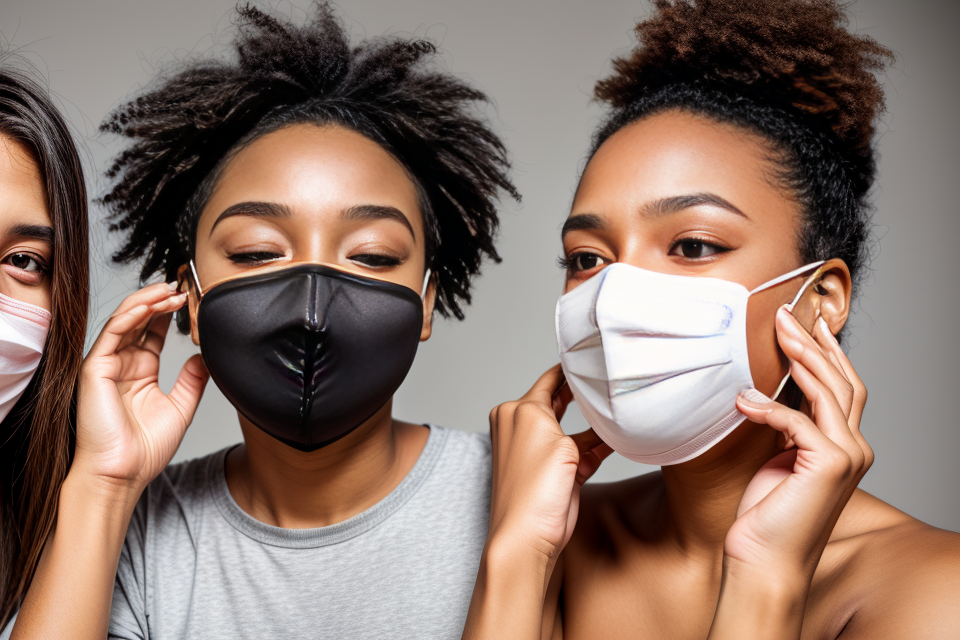Unveiling the ideal frequency for face mask application is a puzzle that many beauty enthusiasts have attempted to solve. While some swear by daily masks, others prefer a more relaxed approach. This guide will provide a comprehensive understanding of the optimal frequency for applying face masks, debunking common misconceptions and offering practical advice for a glowing complexion. Get ready to uncover the secrets to a flawless face!
The Science Behind Face Masks
Understanding the Benefits of Face Masks
Face masks have been used for centuries in various cultures as a beauty and skincare tool. The use of face masks has become increasingly popular in recent years due to their ability to improve the appearance of the skin and provide a range of benefits.
Some of the benefits of using face masks include:
- Deep cleansing: Face masks can help to remove dirt, oil, and impurities from the skin that may not be effectively removed by traditional cleansing methods.
- Exfoliation: Some face masks contain exfoliating agents that can help to remove dead skin cells and promote cell turnover, leading to brighter, smoother skin.
- Hydration: Many face masks are formulated with hydrating ingredients that can help to lock in moisture and prevent dryness.
- Brightening: Some face masks contain ingredients that can help to reduce the appearance of dark spots, hyperpigmentation, and other forms of discoloration.
- Anti-aging: Some face masks contain ingredients that can help to reduce the appearance of fine lines, wrinkles, and other signs of aging.
- Soothing: Some face masks are formulated with ingredients that can help to soothe and calm irritated or sensitive skin.
Overall, the benefits of using face masks are numerous and can help to improve the appearance and health of the skin.
The Role of Active Ingredients in Face Masks
Active ingredients are the key to the effectiveness of face masks. These ingredients can provide a range of benefits to the skin, including hydration, exfoliation, and brightening. The type of active ingredients used in a face mask will depend on the specific needs of the skin. For example, a face mask designed to hydrate the skin may contain ingredients such as hyaluronic acid, while a face mask designed to exfoliate may contain ingredients such as salicylic acid.
It is important to choose a face mask that contains active ingredients that are suitable for your skin type and concerns. For example, those with dry skin may benefit from a face mask that contains ingredients such as ceramides or glycerin, while those with oily skin may benefit from a face mask that contains ingredients such as charcoal or tea tree oil.
In addition to the type of active ingredients used, the concentration of these ingredients is also important. Some active ingredients may be more effective at higher concentrations, while others may be more effective at lower concentrations. It is important to follow the instructions on the face mask packaging to ensure that you are using the product correctly and effectively.
It is also important to note that some active ingredients can be irritating to the skin, especially if used in high concentrations. It is important to patch test a new face mask on a small area of the skin before applying it to the entire face to ensure that it does not cause any irritation.
Overall, the active ingredients in a face mask play a crucial role in its effectiveness. By choosing a face mask that contains suitable active ingredients and using it correctly, you can achieve the best results for your skin.
Factors Affecting Face Mask Efficacy
The Importance of Skin Type
-
Understanding Your Skin Type
- Dry Skin
- Characteristics
- Lack of oil and water in the skin
- Tendency to be rough and flaky
- Benefits of Masks
- Hydration
- Barrier repair
- Recommended Masks
- Hyaluronic acid masks
- Moisturizing masks
- Characteristics
- Oily Skin
* Excess oil production
* Tendency to be shiny and acne-prone
* Deep cleansing
* Pore unclogging
* Charcoal masks
* Kaolin clay masks - Combination Skin
* Mix of dry and oily areas
* Tendency to be sensitive
* Balancing actives
* Soothing and calming
* Multifunctional masks
* Soothing and calming masks - Sensitive Skin
* Reacts easily to stimuli
* Tendency to be red and inflamed
* Calming and soothing
* Gentle and natural ingredients - Mature Skin
* Thin and delicate
* Tendency to be dry and wrinkled
* Collagen boosting
* Hydrating masks
* Antioxidant-rich masks - Acne-Prone Skin
* Clogged pores and blemishes
* Tendency to be oily and shiny
* Salicylic acid masks - Sensitive to the Sun Skin
* Sun-damaged skin
* Tendency to be dry and rough
* Sun protection
* Sun protection masks - Aging Skin
- Rosacea-Prone Skin
* Redness and inflammation
- Dry Skin
-
Identifying Your Skin Type
- In-Depth Analysis
- Understanding the specific needs of your skin
- Evaluating the results of different masks
- In-Depth Analysis
The Influence of Environmental Factors
The efficacy of face masks can be significantly influenced by environmental factors. These factors include temperature, humidity, and pollution levels. Understanding how these environmental factors impact the performance of face masks is crucial in determining the optimal frequency for their application.
- Temperature: The efficacy of face masks can be affected by temperature. For instance, in hot temperatures, face masks may become less effective due to increased perspiration, which can cause the mask to become wet and less efficient at filtering out pollutants. In contrast, in cold temperatures, the skin may become dry, which can make it more difficult for the face mask to adhere properly to the skin. Therefore, it is important to consider the temperature when determining the optimal frequency for applying face masks.
- Humidity: Humidity levels can also impact the efficacy of face masks. High humidity levels can cause the mask to become wet and less effective at filtering out pollutants. On the other hand, low humidity levels can cause the skin to become dry, which can make it more difficult for the face mask to adhere properly to the skin. Therefore, it is important to consider the humidity levels when determining the optimal frequency for applying face masks.
- Pollution Levels: Pollution levels can also affect the efficacy of face masks. In areas with high levels of pollution, face masks may need to be applied more frequently to provide adequate protection. However, in areas with low levels of pollution, face masks may only need to be applied occasionally. Therefore, it is important to consider the pollution levels when determining the optimal frequency for applying face masks.
Overall, understanding the influence of environmental factors on the efficacy of face masks is crucial in determining the optimal frequency for their application.
The Role of Lifestyle Habits
When it comes to achieving the optimal frequency for applying face masks, lifestyle habits play a crucial role. Certain lifestyle factors can impact the efficacy of face masks, including diet, stress levels, and overall skin health. Here’s a closer look at the role of lifestyle habits in achieving the best results from face masks.
Diet
Diet can significantly impact the health of your skin, which in turn affects the efficacy of face masks. A diet rich in fruits, vegetables, and other nutrient-dense foods can help improve skin health and promote healthy skin cell function. On the other hand, a diet high in processed foods, sugar, and saturated fats can lead to inflammation and premature aging, which can negatively impact the results of face masks.
Stress Levels
Stress can also have a significant impact on the efficacy of face masks. Chronic stress can lead to inflammation and can negatively impact the health of your skin. This can result in reduced absorption of nutrients and increased sensitivity to environmental factors, both of which can affect the results of face masks. It’s important to find ways to manage stress, such as through exercise, meditation, or therapy, to achieve the best results from face masks.
Skin Health
Overall skin health is another crucial factor in achieving the optimal frequency for applying face masks. Factors such as acne, dryness, or sensitivity can impact the efficacy of face masks. For example, if you have acne-prone skin, using a face mask too frequently can lead to further irritation and clogged pores. It’s important to understand your skin type and any specific skin concerns you may have in order to determine the best frequency for applying face masks.
In conclusion, lifestyle habits play a crucial role in achieving the optimal frequency for applying face masks. Factors such as diet, stress levels, and overall skin health can all impact the efficacy of face masks. By addressing these lifestyle factors, you can help optimize the results of your face masks and achieve healthier, more radiant skin.
Recommended Frequency for Face Mask Use
The General Rule of Thumb
When it comes to determining the optimal frequency for applying face masks, a general rule of thumb is to use them once or twice a week. This recommendation is based on the idea that overusing face masks can strip the skin of its natural oils, leading to dryness and irritation. However, this recommendation may vary depending on the individual’s skin type and needs.
It’s important to note that not all face masks are created equal, and some may be more appropriate for daily use than others. For example, clay masks are often recommended for their deep pore cleansing properties, but they can also be drying if used too frequently. On the other hand, hydrating masks may be better suited for daily use for those with dry or sensitive skin.
Ultimately, the optimal frequency for applying face masks will depend on a variety of factors, including skin type, sensitivity, and individual preferences. It’s important to listen to your skin and adjust your masking routine accordingly.
Personalized Skincare: Tailoring the Frequency to Your Needs
Applying face masks is a popular skincare routine for many individuals. However, the optimal frequency for using face masks may vary depending on individual skin type and needs. Personalized skincare involves tailoring the frequency of face mask use to suit your specific skin concerns. This guide will provide you with essential information on how to determine the best frequency for your face mask routine.
Understanding Your Skin Type
The first step in personalized skincare is to understand your skin type. There are several skin types, including oily, dry, combination, and sensitive skin. Each skin type has unique needs, and using the wrong type of face mask can worsen your skin concerns. For example, using a face mask that is too drying for dry skin can lead to further dryness and irritation. Therefore, it is crucial to identify your skin type and choose a face mask that is suitable for your skin type.
Assessing Your Skin Concerns
The next step is to assess your skin concerns. Common skin concerns include acne, dryness, dullness, fine lines, and hyperpigmentation. Different face masks target different skin concerns, and it is essential to choose a face mask that addresses your specific skin concerns. For example, if you have acne-prone skin, you may want to choose a face mask that contains salicylic acid or tea tree oil to help unclog pores and reduce inflammation.
Frequency of Use
The frequency of face mask use depends on your skin type and concerns. Generally, it is recommended to use a face mask once or twice a week. However, if you have dry or sensitive skin, you may want to use a face mask less frequently to avoid further dryness or irritation. On the other hand, if you have oily or acne-prone skin, you may want to use a face mask more frequently to help control oil production and reduce breakouts.
Building a Skincare Routine
Once you have identified your skin type, assessed your skin concerns, and determined the frequency of use, you can build a skincare routine that includes face masks. It is essential to choose a face mask that is suitable for your skin type and concerns and use it at the recommended frequency. Additionally, incorporating other skincare products, such as serums and moisturizers, can help enhance the effectiveness of your face mask routine.
In conclusion, personalized skincare involves tailoring the frequency of face mask use to suit your specific skin type and concerns. By understanding your skin type, assessing your skin concerns, and determining the frequency of use, you can build a skincare routine that includes face masks to help achieve your desired skin goals.
Considering Professional Advice
When it comes to determining the optimal frequency for applying face masks, it is important to consider the advice of professionals in the field. Here are some factors that experts take into account when recommending a frequency for face mask use:
Skin Type and Condition
One of the primary factors that professionals consider when recommending a frequency for face mask use is the individual’s skin type and condition. Those with oily or acne-prone skin may benefit from using face masks more frequently, while those with dry or sensitive skin may need to use them less frequently.
Skin Concerns and Goals
Another important factor to consider is the individual’s specific skin concerns and goals. For example, those with dry skin may want to focus on hydrating masks, while those with acne-prone skin may want to focus on masks that are designed to combat breakouts. Professionals can help individuals determine the best frequency for using face masks based on their specific concerns and goals.
Product Ingredients and Effectiveness
Finally, professionals may also take into account the ingredients in the face masks and their effectiveness. Some face masks may be more potent or effective when used less frequently, while others may be safe for daily use. By considering the specific ingredients in a face mask, professionals can help individuals determine the optimal frequency for using the product.
Overall, it is important to consult with a professional before determining the optimal frequency for applying face masks. By taking into account factors such as skin type and condition, skin concerns and goals, and product ingredients and effectiveness, professionals can help individuals achieve the best results from their face mask routine.
Common Face Mask Misconceptions
Myth: More is Better
One of the most prevalent misconceptions when it comes to face masks is that using them more frequently will yield better results. This could not be further from the truth. In fact, overusing face masks can lead to irritation, dryness, and even more severe skin problems.
There are several reasons why this myth persists. For one, many people assume that using a face mask more often will help to speed up the skin’s natural renewal process. However, the skin has its own natural rhythm and is capable of regenerating itself without the need for excessive intervention.
Additionally, some individuals may feel that using a face mask more frequently will help to address specific skin concerns, such as acne or hyperpigmentation. While certain face masks can provide temporary relief for these issues, relying on them too often can actually exacerbate the problem.
So, what is the optimal frequency for applying face masks? The answer varies depending on individual skin type and concerns. However, as a general rule of thumb, it is recommended to use a face mask no more than once or twice a week.
Moreover, it is important to choose the right type of face mask for your skin. For example, those with dry or sensitive skin may benefit from using a hydrating face mask, while those with oily skin may prefer a purifying face mask. Using the wrong type of face mask can lead to further irritation and dryness.
In conclusion, the myth that more is better when it comes to face masks is simply not true. Overusing face masks can lead to skin irritation and dryness, and may even exacerbate existing skin concerns. Instead, it is important to use face masks sparingly and choose the right type for your skin.
Myth: All Face Masks are Created Equal
One common misconception about face masks is that they are all created equal. Unfortunately, this could not be further from the truth. Face masks come in a variety of forms, each with its own unique properties and benefits. For example, some face masks are designed to moisturize and hydrate the skin, while others are formulated to draw out impurities and unclog pores. Additionally, some face masks are designed for use on specific skin types, such as oily or dry skin, while others are more universal.
Another factor to consider is the ingredients used in face masks. Some may contain natural ingredients like clay or charcoal, while others may rely on chemicals and synthetic ingredients. It’s important to note that while some chemicals may be effective at treating skin concerns, they can also be harsh and potentially damaging to the skin if used too frequently or in high concentrations.
Furthermore, the frequency of use can also play a role in the effectiveness of a face mask. Some face masks may be designed for daily use, while others may only need to be used once or twice a week. It’s important to follow the instructions on the packaging and adjust your routine accordingly. Overusing a face mask can lead to dryness, irritation, and even damage to the skin.
Overall, it’s important to understand that not all face masks are created equal and that finding the right one for your skin type and concerns may take some trial and error. By taking the time to research and understand the different types of face masks available, you can find the one that best suits your needs and achieve the results you’re looking for.
Myth: Face Masks are a Replacement for a Good Skincare Routine
Applying face masks can be a part of a comprehensive skincare routine, but it is not a replacement for one. While face masks can provide temporary hydration, brightening, and other benefits, they are not a long-term solution for maintaining healthy skin.
It is important to note that face masks are not a replacement for a well-rounded skincare routine that includes cleansing, toning, moisturizing, and using sunscreen. These steps are crucial for maintaining healthy skin and preventing damage from environmental factors such as pollution and UV rays.
Additionally, using a face mask too frequently or in place of other skincare steps can lead to dryness, irritation, and other skin problems. It is recommended to follow a consistent skincare routine that includes face masks as an occasional treatment rather than a daily practice.
Overall, incorporating face masks into your skincare routine can be beneficial, but it is important to understand their limitations and use them in conjunction with other skincare steps for optimal results.
Ensuring Optimal Results from Face Masks
Preparing the Skin Before Applying a Face Mask
Proper preparation of the skin is crucial for achieving optimal results from face masks. The skin should be clean, dry, and free from impurities before applying a face mask. This can be achieved by following these steps:
- Cleanse the skin thoroughly: Use a gentle, non-abrasive cleanser to remove dirt, oil, and makeup from the skin. It is important to remove all traces of impurities to ensure that the face mask can penetrate the skin effectively.
- Pat the skin dry: Use a clean towel to gently pat the skin dry. Avoid rubbing the skin as this can cause irritation.
- Choose the right face mask: Select a face mask that is suitable for your skin type and concerns. For example, if you have oily skin, choose a clay-based face mask to absorb excess oil. If you have dry skin, choose a hydrating face mask to moisturize the skin.
- Follow the instructions: Read the instructions on the face mask packaging carefully and follow them precisely. Some face masks may require activation with water or a moisturizer before application.
- Apply the face mask evenly: Apply the face mask evenly over the face, avoiding the eyes and mouth. Use a spatula or your fingers to spread the mask evenly.
- Wait for the recommended time: Allow the face mask to sit on the skin for the recommended time before rinsing it off. This will give the active ingredients in the face mask enough time to penetrate the skin and deliver their benefits.
By following these steps, you can prepare your skin effectively before applying a face mask and ensure optimal results from your skincare routine.
The Correct Application Technique
Proper application technique is crucial to achieving the optimal results from face masks. Follow these steps to ensure effective use:
- Clean your skin thoroughly before applying a face mask. This helps to remove dirt, oil, and other impurities that may interfere with the mask’s efficacy.
- Apply a generous amount of the face mask to your face, ensuring that it is evenly distributed. Pay particular attention to areas with larger pores or blemishes.
- Allow the face mask to sit on your skin for the recommended duration. This time varies depending on the type of mask and its intended purpose. Generally, clay masks should be left on for 10-15 minutes, while peel-off masks can be used for 15-20 minutes.
- Gently remove the face mask by massaging it into your skin in a circular motion. This helps to exfoliate and remove dead skin cells, revealing brighter, smoother skin.
- Rinse your face with lukewarm water to remove any remaining residue. Pat your skin dry with a clean towel, and follow up with a moisturizer or serum, if desired.
By following these steps, you can ensure that your face mask is applied correctly and maximize its potential benefits.
Following Up with a Moisturizer and Sunscreen
After applying a face mask, it is crucial to follow up with a moisturizer and sunscreen to ensure optimal results. These two steps can help to lock in the benefits of the face mask and protect the skin from environmental stressors.
Moisturizer
Applying a moisturizer after using a face mask is essential to keep the skin hydrated and nourished. The moisturizer should be lightweight and non-greasy to avoid clogging pores or causing breakouts. Look for a moisturizer that contains hydrating ingredients such as hyaluronic acid, glycerin, or ceramides to help the skin retain moisture.
Sunscreen
Protecting the skin from the sun’s harmful UV rays is vital, and applying sunscreen after using a face mask is an essential step in preventing premature aging and skin cancer. Look for a broad-spectrum sunscreen with an SPF of at least 30 that provides both UVA and UVB protection. It is recommended to use a physical sunscreen that contains ingredients such as zinc oxide or titanium dioxide, which sit on top of the skin and provide a physical barrier against the sun’s rays.
It is also essential to note that wearing a face mask does not provide sufficient sun protection, and applying sunscreen is still necessary even when using a face mask. In fact, some face masks can make the skin more sensitive to the sun, so it is even more crucial to wear sunscreen after using a face mask.
In summary, following up with a moisturizer and sunscreen after using a face mask is crucial to ensure optimal results and protect the skin from environmental stressors. Be sure to choose lightweight, non-greasy moisturizers that contain hydrating ingredients and broad-spectrum sunscreens with at least SPF 30 for effective protection against the sun’s harmful UV rays.
Monitoring Your Skin’s Response
Monitoring your skin’s response to face masks is a crucial step in ensuring optimal results. It involves paying close attention to any changes in your skin’s texture, tone, and overall appearance after using a face mask. Here are some key things to keep in mind when monitoring your skin’s response:
- Skin Type: Your skin type can affect how your skin responds to face masks. If you have oily skin, for example, you may notice that a face mask leaves your skin feeling more oily or congested. If you have dry skin, on the other hand, you may notice that a face mask leaves your skin feeling hydrated and smooth.
- Skin Sensitivity: Some people may experience skin sensitivity or irritation after using a face mask. If you notice any redness, itching, or discomfort after using a face mask, it’s important to discontinue use and consult a dermatologist if necessary.
- Skin Concerns: If you have specific skin concerns, such as acne, rosacea, or hyperpigmentation, it’s important to monitor how a face mask affects your skin. Some face masks may exacerbate certain skin concerns, while others may help to alleviate them.
- Timing: Timing is also important when monitoring your skin’s response to face masks. If you use a face mask too frequently, your skin may become overloaded and start to produce excess oil or become dry and flaky. On the other hand, if you don’t use a face mask often enough, your skin may not receive the nourishment and hydration it needs.
Overall, monitoring your skin’s response to face masks is an important step in ensuring that you are using them effectively and safely. By paying close attention to your skin’s texture, tone, and overall appearance, you can make informed decisions about how often to use face masks and which types of face masks are best for your skin.
Modifying Your Face Mask Regimen as Needed
Modifying your face mask regimen as needed is a crucial aspect of ensuring optimal results from your skincare routine. This involves taking into account factors such as your skin type, current concerns, and sensitivity to determine the best approach for your unique needs.
One key aspect of modifying your face mask regimen is understanding the different types of face masks available and their specific benefits. For example, clay masks are great for deep cleansing and drawing out impurities, while hydrating masks are ideal for moisture-depleted skin. By choosing the right type of mask for your skin, you can tailor your regimen to address your specific concerns.
Another important factor to consider is the frequency of use. Overuse of face masks can lead to irritation and dryness, while underuse can result in ineffective treatment. It’s essential to find the right balance and adjust your regimen accordingly.
Here are some tips for modifying your face mask regimen as needed:
- Start with a patch test: Before using a new face mask, perform a patch test on a small area of your skin to ensure that you don’t experience any adverse reactions.
- Listen to your skin: Pay attention to how your skin feels after using a face mask. If it feels dry, irritated, or uncomfortable, it may be a sign that you need to adjust your regimen.
- Experiment with different ingredients: Try incorporating different ingredients into your face mask routine to address specific concerns. For example, charcoal can help draw out impurities, while aloe vera can soothe sensitive skin.
- Consider your lifestyle: Your lifestyle can also impact the effectiveness of your face mask regimen. For example, if you have oily skin, you may need to use a face mask more frequently to keep pores clear.
By modifying your face mask regimen as needed, you can ensure that you’re getting the most out of your skincare routine and achieving the results you desire.
Consulting a Dermatologist for Advice
Consulting a dermatologist for advice is an essential step in ensuring optimal results from face masks. A dermatologist is a medical doctor who specializes in the diagnosis and treatment of skin conditions. They are knowledgeable about the various types of face masks available and can provide personalized recommendations based on an individual’s skin type and concerns.
When consulting a dermatologist for advice on face masks, it is important to ask the following questions:
- What type of face mask is best for my skin type and concerns?
- How often should I use the face mask for optimal results?
- Are there any side effects or contraindications I should be aware of?
- Can the face mask be used in conjunction with other skincare products?
It is also important to follow the dermatologist’s recommendations carefully and consistently to achieve optimal results from face masks.
Additionally, a dermatologist may recommend other skincare treatments in addition to face masks, such as topical creams or chemical peels, to address specific skin concerns.
In summary, consulting a dermatologist for advice is crucial in ensuring optimal results from face masks. A dermatologist can provide personalized recommendations based on an individual’s skin type and concerns and can also recommend other skincare treatments if necessary.
Further Reading
- For those looking to delve deeper into the topic of face masks and their application, several resources are available to provide further information.
- Books such as “The Natural Beauty Bible” by Kirsty Wark and “The Green Beauty Guide” by Julie Gabriel offer comprehensive guides to natural and organic skincare, including information on the use of face masks.
- Online resources such as blogs and forums can also provide valuable information on the topic. Websites such as “The Beauty of Life” and “Green Beauty Blog” offer tips and advice on natural skincare, including information on the optimal frequency for applying face masks.
- Additionally, scientific journals such as “Skin Pharmacology and Physiology” and “International Journal of Cosmetic Science” publish research on the efficacy and safety of various skincare products, including face masks. These resources can provide valuable insights into the science behind face masks and their application.
- Finally, consulting with a dermatologist or other healthcare professional can provide personalized advice on the optimal frequency for applying face masks based on individual skin type and concerns.
FAQs
1. How often should I apply a face mask?
Applying a face mask too frequently can strip your skin of its natural oils and cause irritation. On the other hand, not using a face mask often enough can leave your skin prone to dullness, breakouts, and other issues. As a general rule, it’s recommended to use a face mask once or twice a week, depending on your skin type and needs.
2. Can I use a face mask every day?
Using a face mask every day can be too drying and damaging to your skin. Overuse of face masks can strip your skin of its natural oils, leading to redness, irritation, and even more breakouts. It’s recommended to use a face mask no more than once a day, and give your skin time to recover in between treatments.
3. What are the benefits of using a face mask?
Face masks can provide a variety of benefits for your skin, depending on the type of mask you use. Some face masks can help brighten and hydrate your skin, while others can target specific skin concerns like acne, blackheads, or hyperpigmentation. Using a face mask regularly can help improve the overall health and appearance of your skin.
4. How long should I leave a face mask on my skin?
The recommended application time for a face mask can vary depending on the specific product and your skin type. Typically, it’s recommended to leave a face mask on for about 10-15 minutes before rinsing it off with lukewarm water. If you have sensitive skin, you may want to start with a shorter application time and gradually increase it as your skin becomes more accustomed to the treatment.
5. Can I use a face mask with other skincare products?
Yes, you can use a face mask with other skincare products. In fact, using a face mask in conjunction with other treatments can be an effective way to target multiple skin concerns at once. However, it’s important to use a face mask after cleansing your skin and before applying other products, to ensure that your skin is clean and free of any impurities that could interfere with the effectiveness of the mask.









